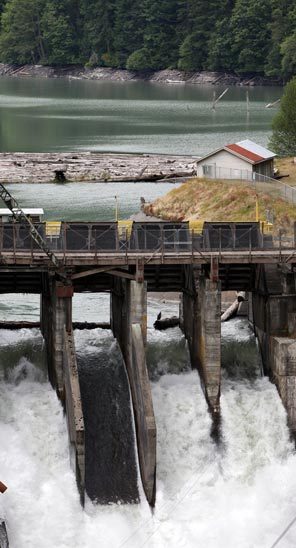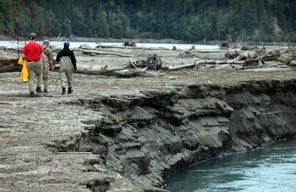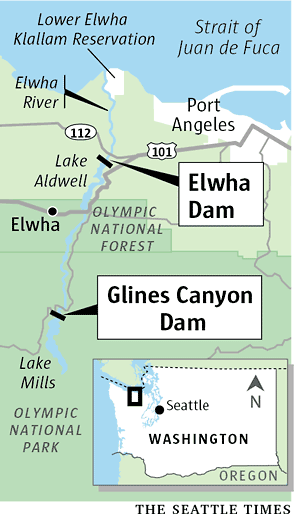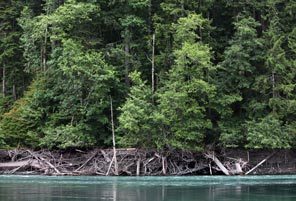Originally published July 24, 2011 at 10:01 PM | Page modified September 21, 2011 at 4:17 PM
Elwha River reborn as landscape transforms
The Elwha River is re-emerging as Lake Aldwell and Lake Mills reservoirs are drawn down in preparation for the beginning of dam removal in September.
Seattle Times staff reporter
STEVE RINGMAN / THE SEATTLE TIMES
Water crashes over Elwha Dam as Lake Aldwell is drawn down. The dam is one of two that soon will be removed in an effort to restore salmon runs.
![]()
The Elwha River is re-emerging, flowing in a bright green ribbon where just a month ago there was a lake.
And there's the sound: The river, tumbling and even kicking up a little white water, breaking a century's silence in the landscape of former Lake Aldwell.
"First, the sound," said Brian Cluer of NOAA fisheries, surveying the delta last week, "then the salmon."
The reservoirs behind both dams, Lake Aldwell and Lake Mills, are being drawn down in preparation for the start of dam removal Sept. 17. Taking out Elwha and Glines Canyon dams on the river is part of the $325 million Elwha restoration program now under way, intended to bring back the river's legendary salmon runs.
The reservoirs already have dropped about 12 feet, revealing a transformed landscape: The river is re-emerging, the lakes disappearing and the shoreline showing. So are acres of sediment impounded by the dams, once under the lakes, but now high and dry. Lake Aldwell already has come down as far as it can, until the dam itself is gradually removed. Lake Mills has three more feet to go before the top sill of that dam is reached.
Drawdown should be finished in about two weeks. And as the lakes drop, quite a show is under way.
Downstream, power generation at both dams was switched off June 1, so water from the drawdown plus the inflow from a snowpack at about 200 percent of average is barreling through the spillways.
At Elwha Dam last week, torrents fumed downriver, and roostertails of whitewater exploded halfway up the canyon walls with the violence of the flow. Giant boulders at the base of the dam, several stories high, visible and even walkable in later summer, are lost in the tumult.
But upriver is where the real drama is unfolding: the re-emergence of the drowned landscape.
Already, both lakes have dropped so much, docks wander off to nowhere and paths trail to a 12-foot drop to where the lake used to be. Shoreline vegetation looks as if clipped by a barber, dead-level all along where the waterline was. And the river is slicing through deltas of sediment stuck behind the dams, layered as much as 60 feet thick above Glines Canyon and about half of that at Elwha.
The river is being left to do the work of sluicing the sediment downriver. As the river gradient continues to drop, first with reservoir drawdown, and then with dam removal, it will keep chewing away at its task.
Scientists from the National Park Service, Bureau of Reclamation and NOAA Fisheries walked the deltas and banks last week to explore what the river has done so far; make measurements and chart progress of the river's restoration.
Tim Randle of the Bureau of Reclamation's Denver office, helping to lead the team of scientists tracking erosion of the sediment, said he was astounded to see how much the deltas have eroded since he last visited in May and drawdown got under way in June.
"It's completely transformed," Randle said of the landscape, adding that so far, both deltas are eroding in a fashion that is in keeping with the restoration plan. The goal is to leave behind gradually stepped-down terraces of sediment on the shore and natural-looking islands in the river. Unstable, steep slopes and 30- to 60-foot-tall stranded pillars of material would be unsightly and potentially hazardous.
In addition to the force of the river, large woody debris carried by the Elwha is expected to carve and shape the landscape, as logs direct the river's flow. "It's not just sediment and water; there are big pieces of wood that are very influential," Cluer said. "There's a lot of it here now, and a lot more coming." A native of the Northwest now working in NOAA's Santa Rosa office in California, he has worked on dam removals his entire career — but never one like this, the largest ever in North America.
"It's exciting to come home to the Elwha and see it get reborn," Cluer said. "I think it will happen fast."
Already a few grasses could be seen taking hold in the sediment, as well as a small, daisylike flower. "It's going to look pretty natural to a lot of folks very soon," Randle said.
Places like these, far from any seed source on the banks, will, as part of the restoration plan, also be planted with trees, shrubs and other native plants intended to beat out colonizing invasive weeds, and grow a more natural-looking landscape.
Kevin Yancy, director of the Elwha project office for the Bureau of Reclamation, spent Wednesday helping his crew pack up tools from the dams in a U-Haul van, to drive to other Reclamation project offices in Yakima.
With the dams switched off, he'll be leaving the Elwha Project office for good soon — it will be bulldozed as part of the restoration. The dams already have been picked over for their period instruments for placement with museums and historic societies.
"The museums are real happy," Yancy said. Then he went back to work packing up, as the river roared past.
Lynda V. Mapes: 206-464-2736 or lmapes@seattletimes.com















